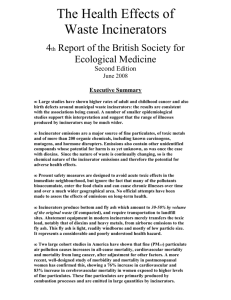Myths and Facts - Sanctuary Asia
advertisement
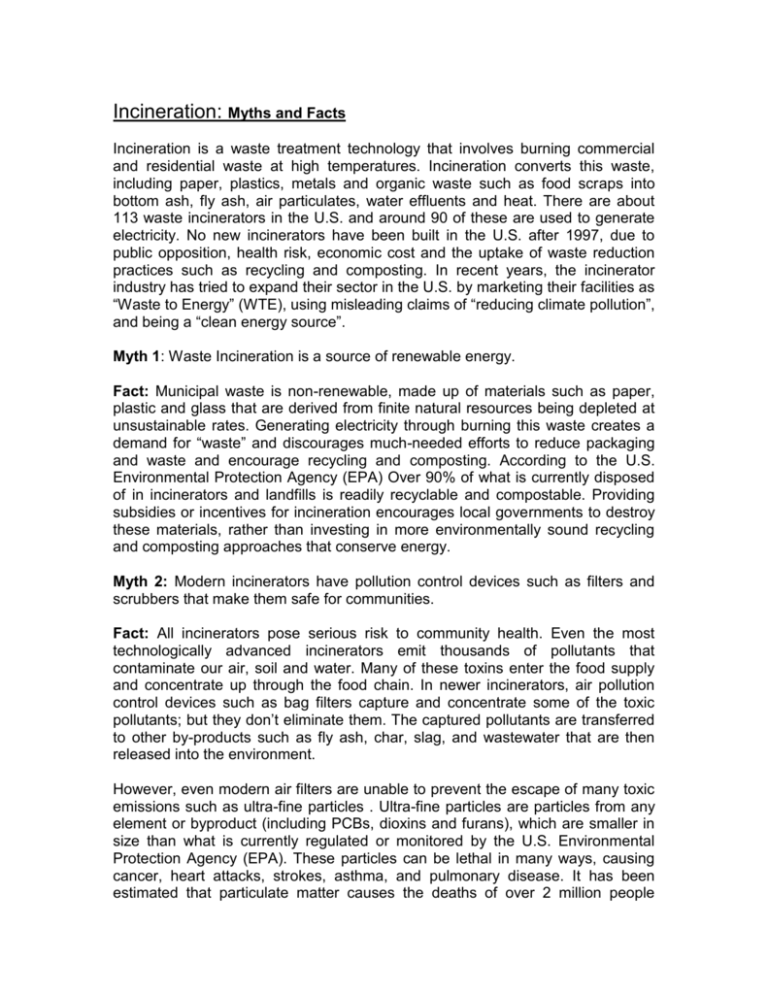
Incineration: Myths and Facts Incineration is a waste treatment technology that involves burning commercial and residential waste at high temperatures. Incineration converts this waste, including paper, plastics, metals and organic waste such as food scraps into bottom ash, fly ash, air particulates, water effluents and heat. There are about 113 waste incinerators in the U.S. and around 90 of these are used to generate electricity. No new incinerators have been built in the U.S. after 1997, due to public opposition, health risk, economic cost and the uptake of waste reduction practices such as recycling and composting. In recent years, the incinerator industry has tried to expand their sector in the U.S. by marketing their facilities as “Waste to Energy” (WTE), using misleading claims of “reducing climate pollution”, and being a “clean energy source”. Myth 1: Waste Incineration is a source of renewable energy. Fact: Municipal waste is non-renewable, made up of materials such as paper, plastic and glass that are derived from finite natural resources being depleted at unsustainable rates. Generating electricity through burning this waste creates a demand for “waste” and discourages much-needed efforts to reduce packaging and waste and encourage recycling and composting. According to the U.S. Environmental Protection Agency (EPA) Over 90% of what is currently disposed of in incinerators and landfills is readily recyclable and compostable. Providing subsidies or incentives for incineration encourages local governments to destroy these materials, rather than investing in more environmentally sound recycling and composting approaches that conserve energy. Myth 2: Modern incinerators have pollution control devices such as filters and scrubbers that make them safe for communities. Fact: All incinerators pose serious risk to community health. Even the most technologically advanced incinerators emit thousands of pollutants that contaminate our air, soil and water. Many of these toxins enter the food supply and concentrate up through the food chain. In newer incinerators, air pollution control devices such as bag filters capture and concentrate some of the toxic pollutants; but they don’t eliminate them. The captured pollutants are transferred to other by-products such as fly ash, char, slag, and wastewater that are then released into the environment. However, even modern air filters are unable to prevent the escape of many toxic emissions such as ultra-fine particles . Ultra-fine particles are particles from any element or byproduct (including PCBs, dioxins and furans), which are smaller in size than what is currently regulated or monitored by the U.S. Environmental Protection Agency (EPA). These particles can be lethal in many ways, causing cancer, heart attacks, strokes, asthma, and pulmonary disease. It has been estimated that particulate matter causes the deaths of over 2 million people around the world each year - 370, 000 of them in Europe . In the U.S. communities of color, low-income communities, and Indigenous communities are exposed to a disproportionate burden of such toxins. Myth 3: Modern incinerators produce less climate pollution - carbon dioxide (CO2) Fact: Burning waste is very climate destructive. Incinerators emit more carbon dioxide (CO2) per megawatt hour (MW/h) of electricity than coal-fired power plants. According to the Environmental Protection Agency, “waste to energy” incineration and landfills contribute far higher levels of lifecycle greenhouse gas emissions and overall energy use than source reduction, reuse and recycling of the same materials. Incineration also drives a climate changing cycle of new resources pulled out of the earth, processed in factories, shipped around the world, and then wasted in burners and landfills. A 2009 study by the EPA concluded that up to 42% of U.S. GHG emissions could be mitigated through zero waste strategies such recycling and composting. Myth 4: Modern incinerators efficiently produce electricity Fact: All incinerators are a massive waste of energy. Due to the low calorific value of waste, incinerators are only able to capture small amounts of energy by destroying large amounts of reusable materials. While older incinerators generate electricity at very low efficiency rates of 19-27%, a recent UK study found that conversion efficiencies of new incineration technologies are even lower. Conversely, zero waste practices such as recycling and composting serve to conserve three to five times the amount of energy produced by waste incineration. When taken together, the amount of energy wasted in the U.S. by not recycling aluminum and steel cans, paper, printed materials, glass, and plastic is equal to the annual output of 15 medium-sized power plants. Myth 5: Incinerators provide jobs for communities Fact: Incinerators burn local jobs. Incinerators require huge capital investment, but they offer relatively few jobs when compared to recycling. In fact, recycling sustains more than 10 times more jobs per ton of waste than incineration and landfilling. With a national recycling rate of less than 33%, the U.S. recycling industries currently provide 1.1 million jobs. If the national recycling rate were to double, over a million new jobs could be created. Myth 6: Incinerators are an affordable waste management option Fact: Incinerators create massive economic burdens for communities. Billions of taxpayer dollars are spent subsidizing the construction and operations of incinerators. Detroit taxpayers are saddled with over $1.2 billion dollars in debt from constructing and upgrading the world’s largest waste incinerator. As a result, residents have had to pay high trash disposal fees of over $150 per ton. This year, the city of Harrisburg, PA is considering filing for bankruptcy due to its outstanding incinerator debt of $300 million. Harrisburg’s annual incinerator debt payments are currently $68 million, larger than the city's entire operating budget. For a fraction of these costs, investments in recycling, reuse and remanufacturing would create significantly more business and employment opportunities. Myth 7: Incinerators are compatible with recycling Fact: Incinerators burn many valuable resources that can be recycled and composted, and incinerators compete for the same materials as recycling programs. Because of the extremely high costs of constructing and operating an incinerator, spending taxpayer money for an incinerator means that there are significantly less funds to invest in more affordable solutions. More than two thirds of the materials we use are still burned or buried , despite the fact that we can cost-effectively recycle the vast majority of what we waste. Myth 8: Countries like Denmark that are expanding incineration have the highest recycling rates and they only burn materials that cannot be recycled. Fact: Countries and regions in Europe that have high waste incineration rates typically recycle less. Data for household waste from Denmark in 2005 clearly shows that regions with expanded incineration have lower recycling and regions with lower incineration do more recycling. It’s worth noting that Denmark’s recycling rate is well behind other regions of Europe such as Flanders in Belgium, which recycles 71% of municipal waste. Region Hovedstaden Nordjyllnad Sjælland Midtjylland Syddanmark Recycling 21% 29% 31% 40% 41% Incineration 77% 63% 59% 53% 52% Landfill 2% 8% 10% 7% 6% According to Eurostat in 2007, Denmark generates some of the highest per capita waste in the EU (over 1762 lbs. each year) and over 80 % of what is burned in Danish incinerators is recyclable and compostable. A 2009 study reported that Europe throws away resources worth over $6 billion dollars every year by burning and burying materials that can be recycled. Myth 9: Modern European incinerators produce clean energy, less pollution Fact: Waste incinerators in the EU continue to pollute the climate and cause significant public health risk, while burning billions of dollars worth of valuable resources. A recent public health impacts report states that modern incinerators in the EU are a major source of ultra-fine particulate emissions. In 2009, the Advertising Standards Agency in the UK banned the SITA Cornwall waste company from distributing its booklet on incineration for, among other things, making unsubstantiated claims that the UK Health Protection Agency stated that modern incinerators are safe. Myth 10: The EU is way ahead, and the U.S. lags behind in waste reduction and so is India Fact: While many EU countries are ahead of the U.S. in terms of national programs such as healthcare and climate change mitigation, Americans can be proud of some of the benchmarks we have achieved in the waste arena: • The city of San Francisco has achieved a 75% recycling rate of all municipal and commercial waste, and aims to get to Zero Waste by the year 2015 • The Commonwealth of Massachusetts and the States of Rhode Island, Delaware and California have either banned or seriously prohibited waste incineration, in favor or Zero Waste practices and policies. Source: Global Alliance for Incinerator Alternatives (GAIA)
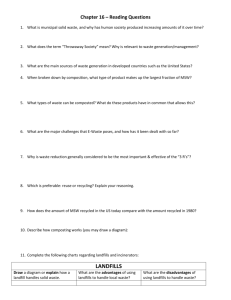
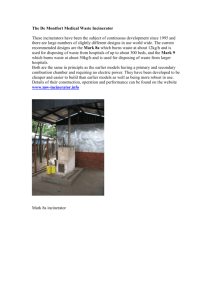


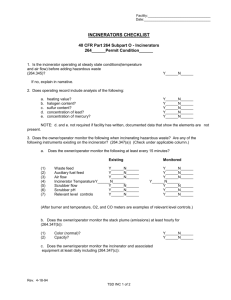
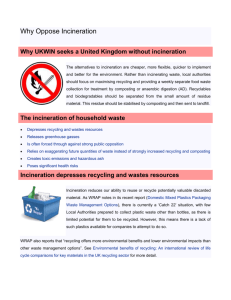
![School [recycling, compost, or waste reduction] case study](http://s3.studylib.net/store/data/005898792_1-08f8f34cac7a57869e865e0c3646f10a-300x300.png)

